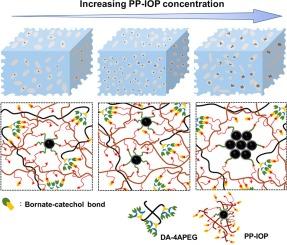Fabrication of multi-responsive dynamic poly(ethylene glycol)-iron oxide nanoparticle nanocomposite hydrogels through interfacial boronate-catechol crosslinking
IF 5.8
2区 化学
Q1 POLYMER SCIENCE
引用次数: 0
Abstract
Poly(ethylene glycol) (PEG)-based nanocomposite (NC) hydrogel with multiple advantageous properties such as high mechanical strength and stimuli-responsiveness have been demonstrated as promising materials across various fields. Here, an innovative type of PEG-based NC hydrogels is fabricated using phenylboronic acid-polyethyleneimine (PBA-PEI)-functionalized iron oxide nanoparticles (PP-IOPs) to crosslink the dopamine-modified 4arm-PEG (DA-4APEG) through boronate-catechol crosslinking. DA-4APEG/PP-IOP NC hydrogels exhibit tunable microstructures (i.e., pore size) and properties (i.e., rheological, mechanical, and swelling behaviors) by changing the number of PP-IOPs in the hydrogel network. With the dynamic crosslinks and magnetic nanoparticles in the network, DA-4APEG/PP-IOP NC hydrogels are self-healable and also responsive to various stimuli, including temperature, pH, glucose, dopamine, hydrogen peroxide, magnetic field, and near-infrared light. Therefore, a versatile PEG-based hydrogel platform has been developed, featuring customizable properties, multiple stimuli-responsiveness, and dynamic characteristics, making it suitable for advanced applications.

通过硼酸盐-儿茶酚界面交联制备多响应动态聚乙二醇-氧化铁纳米颗粒纳米复合水凝胶
聚乙二醇(PEG)基纳米复合材料(NC)水凝胶具有多种优势特性,如机械强度高、刺激响应性强等,已被证明是各领域具有发展前景的材料。本文利用苯硼酸-聚乙烯亚胺(PBA-PEI)-功能化氧化铁纳米粒子(PP-IOPs),通过硼酸盐-儿茶酚交联多巴胺改性4arm-PEG(DA-4APEG),制备了一种创新型PEG基NC水凝胶。通过改变水凝胶网络中 PP-IOPs 的数量,DA-4APEG/PP-IOP NC 水凝胶显示出可调的微结构(即孔径)和性能(即流变、机械和膨胀行为)。由于网络中存在动态交联和磁性纳米粒子,DA-4APEG/PP-IOP NC 水凝胶具有自愈性,并能对温度、pH 值、葡萄糖、多巴胺、过氧化氢、磁场和近红外线等各种刺激做出反应。因此,我们开发出了一种多功能 PEG 基水凝胶平台,它具有可定制的特性、多种刺激响应性和动态特性,使其适用于高级应用。
本文章由计算机程序翻译,如有差异,请以英文原文为准。
求助全文
约1分钟内获得全文
求助全文
来源期刊

European Polymer Journal
化学-高分子科学
CiteScore
9.90
自引率
10.00%
发文量
691
审稿时长
23 days
期刊介绍:
European Polymer Journal is dedicated to publishing work on fundamental and applied polymer chemistry and macromolecular materials. The journal covers all aspects of polymer synthesis, including polymerization mechanisms and chemical functional transformations, with a focus on novel polymers and the relationships between molecular structure and polymer properties. In addition, we welcome submissions on bio-based or renewable polymers, stimuli-responsive systems and polymer bio-hybrids. European Polymer Journal also publishes research on the biomedical application of polymers, including drug delivery and regenerative medicine. The main scope is covered but not limited to the following core research areas:
Polymer synthesis and functionalization
• Novel synthetic routes for polymerization, functional modification, controlled/living polymerization and precision polymers.
Stimuli-responsive polymers
• Including shape memory and self-healing polymers.
Supramolecular polymers and self-assembly
• Molecular recognition and higher order polymer structures.
Renewable and sustainable polymers
• Bio-based, biodegradable and anti-microbial polymers and polymeric bio-nanocomposites.
Polymers at interfaces and surfaces
• Chemistry and engineering of surfaces with biological relevance, including patterning, antifouling polymers and polymers for membrane applications.
Biomedical applications and nanomedicine
• Polymers for regenerative medicine, drug delivery molecular release and gene therapy
The scope of European Polymer Journal no longer includes Polymer Physics.
 求助内容:
求助内容: 应助结果提醒方式:
应助结果提醒方式:


